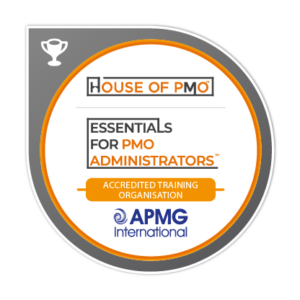
At PMO Learning, some our most popular courses are the P3O® Foundation and P3O® Practitioner certifications.
The P3O® certifications are some of the most widely recognised certifications for those working in a PMO – and at PMO Learning, we’re extremely lucky to have the lead author, Eileen J Roden, as one of our trainers for P3O® courses.
We’ve spoken to Eileen to get under the surface of P3O®, and discover why she’s such an advocate of the suite.
When did you first hear of P3O®?
When I first started working in a PMO, there were no PMO specific qualifications. The first was released in 1998, the BCS PPSO Essentials, which has since been redeveloped as the House of PMO Essentials for PMO Administrators certification.
The first was released in 1998, the BCS PPSO Essentials, which has since been redeveloped as the House of PMO Essentials for PMO Administrators certification.
The first edition of P3O® was released in 2008, which is where I first became aware of it. I was delighted at the introduction of a more specific qualification for those working in PMOs, and got my first P3O® certification quite quickly.
How did you become the lead author of the 2nd edition?
I’d started to get involved with AXELOS when completing reviews for editions of the MoP and PRINCE2 certifications.
When I heard that P3O® was looking to be updated, I was immediately keen to get involved.
It took an application process of applying, demonstrating my PMO experience, demonstrating my writing and communication ability and a final interview to ensure my competency.
Why was the P3O® Manual needed?
Many people who work in and around projects understand the concept of a PMO, however don’t fully understand the term P3O®.
The term P3O® stands for Portfolio, Programmes and Project Offices – and in lots of organisations there are several PMOs. The underlying principle of P3O®, is that rather than just having a smattering of PMOs sitting around an organisation (which isn’t necessarily a bad thing in itself!), if we want to take a strategic approach to delivering projects and programmes within our organisation, then we need to understand and implement structures that assist in this delivery.
 The P3O® model looks to take a structured approach to designing what PMOs we have in our organisation, what each of those PMOs do and who they work to support.
The P3O® model looks to take a structured approach to designing what PMOs we have in our organisation, what each of those PMOs do and who they work to support.
Before the P3O® Manual, and even today, there is lots of literature that teaches us how to set up a PMO within an organisation, however P3O is the only material that I’m aware of that takes a strategic view of structuring PMOs within an organisation.
An interesting aspect of the P3O® is that it doesn’t give you an outright answer – whereas PRINCE2® or MSP® might outline how to do risk management, configuration management or even planning, in the P3O® Manual it is recognised that every PMO is vastly different in each organisation, and so gives delegates a set of questions that we must determine answers for in order to apply to our own particular contexts; using the guidelines to design the correct P3O® structure for your organisation.
Using P3O®, we can decide how many PMOs are required within our organisation, and provide clarity on what each one of those PMOs should do, what services they should provide, and what roles and skills are required by the people in each of those.
What’s the purpose of accreditation?
The P3O® Manual is useful reading for anyone who is interested in PMOs – and who wouldn’t be!
In terms of studing the book and becoming certified, from an individual’s perspective, it’s a great demonstration that you have a good understanding of PMOs, the different types and how they can be pulled together into a P3O® model.
Passing the exam demonstrates our understanding of this, and allows delegates to understand the wider context of their role and do their job better!
For those who go on to complete the P3O® Practitioner, it can be extremely beneficial for those managing and directing PMOs. It’s really about making sure you understand the principles of designing a P3O® for your organisation, and that it’s set up at the right level. It’s also fantastic for allowing delegates to understand where their PMO sits within that P3O® model, and being clear about the scope of each PMO – recognising that this may change.
Do you think that the training and certifications have added value to the industry?
P3O® certifications allow delegates to understand that they are part of a wider P3O® model, meaning adding or removing services needs to be in conjunction with discussions of other PMOs and those in other parts of the business, being able to re-use these services throughout the P3O® structure.
We often find delegates get in touch with us and tell us that completing the courses was the first time they’d even considered the concept of a P3O® model, and had made contact with other PMOs in order to take a more hollistic approach to collaboration between them – allowing them to provide a better offering to their organisation!
What’s your favourite part of the P3O® Manual?
This might be an unusual one, but it’s got to be the appendices!
The chapters work through the question and provide guidelines, but it’s the appendices that might be the most useful part of the Manual.
For example, Appendix A provides a list of the 21 roles described in greater detail, with some bullet points which outline what someone in each role might do. This can be extremely useful if you’re working within a PMO and looking to write a role description in order to recruit.
Appendix F provides a list of all of the potential services that we can deliver as a PMO – from delivery support, to project and programme offices, to centre of excellence offices, and even strategic planning and the enterprise PMO. These are strong references that we can look back on following the course to help us do the job we’ve been appointed to do.
How do you teach P3O® as a trainer?
Every trainer has their own style, and each to their own!
Personally, I like to teach the content not simply to pass the exam, but to allow delegates to come away from the course enthused about their role, really understanding what they can do to make a difference in their organisation, and understand more about the position of the PMO the work in – and it’s future potential when aligned with the P3O® structure!
It goes without saying that we hope delegates are able to pass their exams, but beyond that we want delegates to be enthused to go back to work and improve their PMOs.
A phrase I often use throughout the course is “in textbook land” – I’m always conscious that when we write a textbook, we’re assuming an ideal scenario – which isn’t the world we live in! A lot of the time, thinking about the contexts we actually work in, how they can apply the theory, and how it can help them and be realistically applied to their day-to-day.
What’s your favourite part of teaching P3O®?
Seeing the lights come on in people’s heads – seeing it click in their minds, this is exactly what a PMO is about.
Whilst the profession has come a long way, we still suffer a little bit from the (false!) impression that a PMO is an administrative department, or even worse, a place that doesn’t add value, or is a starting point just to allow people to develop into the project manager role.
The course helps delegates truly value the job that they do, which hugely increases the satisfaction people experience at work. Helping people in recognising that they add value, and how to add value is hugely satisfying.
What advice would you give delegates sitting their P3O® exams?
When sitting the exam, it’s important to recognise that you’re being tested on the content.
For the Foundation level, don’t get caught up on every single word on every single page. There are some key parts of the texts that are examinable, and refer to the syllabus to be absolutely clear on what you need to know and make sure to revise these parts.
We’ve always said that diagrams, charts and tables are a key area to focus on.
For the Practitioner exam, it can be very tempting to do lots of highlighting and tab lots of sections in the P3O® Manual. When doing the Practitioner practice paper, take some time to consider where you have looked in the Manual for help – and tab these parts! There’s probably between 6 and 12 sections you should be referring back to, for example resource sizing.
For both exams, the advise I give all delegates is sit a practice exam just before you do the real thing to get into the right mindset!
If you’re looking to find out more about P3O® certifications, looking to secure your place on an upcoming course or learn more about any of our P3O® trainers, >>click here!
The P3O® courses on this page are offered by PMO Learning. P3O® is a [registered] trade mark of AXELOS Limited. P3O® is a registered trade mark of AXELOS Limited, used under permission of AXELOS Limited. The Swirl logo™ is a trade mark of AXELOS Limited, used under permission of AXELOS Limited. All rights reserved.
Enjoying Our Blog?
Sign up and receive all our articles (we’ll send you an update once a week!) plus special offers and events:











